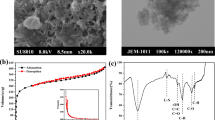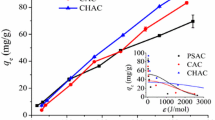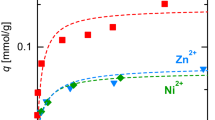Abstract
In order to understand the patterns of the adsorption equilibrium of Cr (III) on activated carbon, the adsorption process was studied by two different ways: classical batch experiments on commercial Norit and Merck activated carbons and their oxidized forms in a wide range of pHs; and extended time-based tests at the same pH values on the same adsorbents. This approach allowed us to understand the role of texture, chemical carbon surface functionality and experimental conditions (initial pH of the solution, contact time and adsorbate/adsorbent ratio) on the effectiveness of Cr (III) removal. The adsorption process of Cr (III) at (24 ± 1∘C) on Merck and Norit activated carbons and their oxidized forms were studied at pH values between 1.5 and 5 (either adjusted or buffered). Chromium concentration was fixed at 200 ppm. The carbon loading ranged from 1.2 to 20 g/l. The carbon/Cr (III) solution contact time was varied from 0.5–1 month to 5 months, to ensure that the saturation of the carbon level was reached. According to the data obtained, the presence of carboxylic groups on carbon surface seems to enhance Cr (III) uptake at initial pH of the solution in the range between 2 and 4. Depending on the nature of the adsorbent surface chemistry, the contact time to reach equilibrium may range from 3 to 5 months. There is an optimum carbon loading which limits the Cr (III) uptake/removal at given pH value. In order to understand the adsorption process, an ion exchange, surface complex and surface precipitation were considered.
Similar content being viewed by others
References
Aggarwal, D., M. Goyal, and R.C. Bansal, “Adsorption of Chromiumby Activated Carbon from Aqueous Solution,” Carbon, 37, 1989 (1999).
Ajmal, M., R.A.K. Rao, R. Ahmad, J. Ahmad, and L.A.K. Rao,“Removal and Recovery of Heavy Metals from Electroplating Wastewater by Using Kyanite as an Adsorbent,” Journal of Hazardous Materials, 87, 127 (2001)
Bautista-Toledo, I., J. Rivera-Utrilla, M.A. Ferro-GarcÍa, and C. Moreno-Castilla “Influence of the Oxygen Surface Complexesof Activated Carbons on the Adsorption of Chromium Ions from Aqueous Solutions: Effect of Sodium Chloride and Humic Acid,”Carbon, 32, 93–100 (1994).
Brigatti, M.F., G. Franchini, C. Lugli, L. Medici, L. Poppi, and E. Turci, “Interaction Between Aqueous Chromium Solutions and Layer Silicates,” Applied Geochemistry, 15, 1307 (2000).
Brown, P.A., S.A. Gill, and S.J. Allen, “Metal Removal from Wastewater Using Peat,” Water Research, 34, 3907(2000).
Burns, C.A., P.J. Cass, I.H. Harding, and R.J. Crawford,“Adsorption of Aqueous Heavy Metals onto Carbonaceous Substrates,” Colloids and Surfaces A: Physicochem. Eng.Aspects, 155, 63 (1999).
Carrott, P.J.M., M.M.L. Ribeiro Carrott, J.M.V. Nabais, and J.P.Prates Ramalho, “Influence of Surface Ionization on the Adsorption of Aqueous Zinc Species by Activated Carbons,” Carbon, 35, 403 (1997).
Chakir, A., J. Bessiere, K.E.L. Kacemi, and B. Marouf, “AComparative Study of the Removal of Trivalent Chromium from Aqueous Solutions by Bentonite and Expanded Perlite,” Journal of Hazardous Materials, 95, 29, (2002).
Chen, J.P. and M. Lin, “Surface Change and Metal Ion Adsorptionon H-type Activated Carbon: Experimental Observation and Modelling Simulation by the Surface Complex Formation Approach,” Carbon, 39, 1491 (2001).
Csobán, K. and P. Joö, “Sorption of Cr (III) on Silicaand Aluminium Oxide: Experiments and Modeling,” Colloids and Surfaces A: Physicochem. Eng. Aspects, 151, 97 (1999).
Csobán, K., M. Párkányi-Berka, P. Joö, and Ph.Behra, “Sorption experiments of Cr(III) onto silica,” Colloids and Surfaces A: Physicochem. Eng. Aspects, 141, 347 (1998).
Ferro-GarcÍa, M.A., J. Rivera-Utrilla, I. Bautista-Toledo, and C. Moreno-Castilla, “Adsorption of Humic Substances on Activated Carbon from Aqueous Solutions and Their Effect on the Removal of Cr(III) Ions,” Langmuir, 14, 1880 (1998).
Figueiredo, J.L., M.F.R. Pereira, M.M.A. Freitas, and J.J.M.örfáo, “Modification of the Surface Chemistry of Activated Carbons,” Carbon, 37, 1379, (1999).
Kratochvil, D., P. Pimentel, and B. Volesky, “Removal of Trivalent and Hexavalent Chromium by Seaweed Biosorbent,” Environmental Science Technology, 32, 2693 (1998).
Kratochvil, D. and B. Volesky, “Advances in the Biosorption of Heavy Metals,” Trends in Biotechnology, 16, 291(1998).
Kumar, A., N.N. Rao, and S.N. Kaul, “Alkali-Treated Straw and Insoluble Straw Xanthate as Low Cost Adsorbents for Heavy Metal Removal—Preparation, Characterization and Application,” Bioresource Technology, 71, 133 (2000).
Lee, K.C., S.K. Low, and K.L. Kek, “Removal of Chromium from Aqueous Solution,” Bioresource Technology, 54, 183 (1995).
Lyubchik, S., R. Melo, C. Palma, and I.M. Fonseca, “Adsorption Equilibrium in the System “Cr (III)—Activated Carbon,” in S. Barany, (ed.), Role of Interfaces in Environmental Protection, NATO ASI Series IV: Earth and Environmental Science, Vol. 24, Kluwer, pp. 355—377 (2003).
Lyubchik, S.I., A.I. Lyubchik, O.L. Galushko, L.P. Tikhonova, J.Vital, I.M. Fonseca, and S.B. Lyubchik, “Kinetics and Thermodynamics of the Cr (III) Adsorption on the Activated Carbonfrom Co-mingled Wastes,” Colloids and Sufaces A:Physicochem. Eng. Aspects, 242, 151 (2004).
Ranganathan, K., “Chromium Removal by Activated Carbons Preparedfrom Casurina Equisetifolia Leaves,” Bioresource Technology, 73, 99 (2000).
Rivera-Utrilla, J., I. Bautista-Toledo, M.A. Ferro-GarcÍa, and C. Moreno-Castilla, “Activated Carbon Surface Modificationsby Adsorption of Bacteria and Their Effect on Aqueous Lead Adsorption,” J. Chem. Technol. Biotechnol., 76, 1209(2001).
Author information
Authors and Affiliations
Rights and permissions
About this article
Cite this article
Lyubchik, S.B., Perepichka, I.I., Galushko, O.L. et al. Optimization of the Conditions for the Cr (III) Adsorption on Activated Carbon. Adsorption 11, 581–593 (2005). https://doi.org/10.1007/s10450-005-5616-1
Received:
Revised:
Accepted:
Issue Date:
DOI: https://doi.org/10.1007/s10450-005-5616-1




